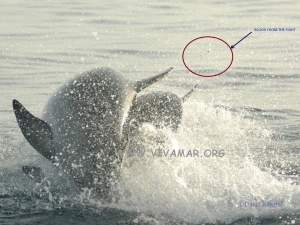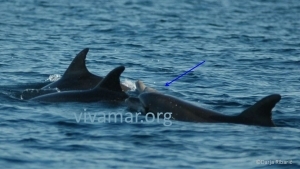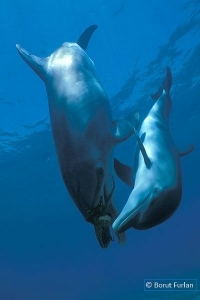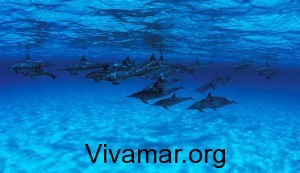Population Size
Dolphins in general are long lived animals. Bottlenose dolphins have a lifespan that can exceed over 50 years for females and up to 45 years for males. They are a very social species and often travel in groups, or pods, that differ in size, varying on average from 2 to 15 individuals. Offshore groups might have up to several hundred individuals. In the northern most Adriatic sea, we notice groups comprised of just two animals, but the average for Slovenia is 8,4 animals (Vivamar observation). Along the west coast of Istria (Croatia), we consistently observe bigger groups with a mean of 12,4 animals. In general, smaller groups of dolphins will further aggregate to much larger groups. These aggregations are often connected to the seasonal availability of prey and conspecific cooperation in activities regarding the prey sources. Populations can travel long distances in search of prey.
Mating
Mating occurs throughout the year but can be seen slightly more frequently in the spring and the fall. Females in the Adriatic become sexually mature at 7-12 years of age (Jagar, 2005), while males are mature at 9-14 years. Research investigating sexual maturity for bottlenose dolphins outside of the Adriatic Sea states the female sexual maturity is between 7-11 years (Cockroft and Ross, 1990). Sexually mature males tend to establish hierarchies and fight intensely over females.
The peak of sexual activity of the bottlenose dolphin in the Adriatic is from the end of March until May. In the field, Vivamar has observed fights which at first glance might seem like an interesting activity but are in fact a serious positioning within a dolphin society.

A serious fight between the bottlenose dolphins in the research area.
After a fight, a male will show preference for a female. The dolphins will form a short term male-female pair that remains for a prolonged period of time. The male will initiate mating by posturing in front of the female and stroking and rubbing her. Jaw clapping, and yelping are also part of pre-copulatory behavior. Courtship can be quite violent and penetration rapid, lasting about 10 seconds but may be repeated. It takes place underwater belly to belly when the female rolls over and presents her ventral side to the male.
Calving
In European waters, offspring are born in early to midsummer. Pregnancy (gestation) lasts 12 months (Cockroft and Ross, 1990). Newborns are 98-120 cm long and weight 9-11kg. Vivamar observes newborn calves annually from May onward.
The interval between calves is normally 2-6 years but can be earlier if the first calf dies. Even 45 year old females have been known to give birth!

A baby dolphin from the current season. Vivamar; ©Darja Ribarič
A newborn calf will typically begin nursing from nipples concealed within a mother’s abdominal mammary slits within 6 hours of being born. Nursing (lactation) of the calf lasts 12-18 months but they sometimes begin to eat solid food at only 6 months old. The newborn calves are darker than adults and have characteristic vertical lines along their bodies, called fetal folds, that they acquire while developing in their mother’s womb. Because the calves’ bodies are still developing and are therefore weaker than their mother’s, they often spend much of the time swimming in the hydrodynamic slip stream of their mother (like a wake behind a boat, but underwater). After the first few days of birth, a mother will whistle (see echolocation, below) constantly to help the calf learn to identify her.

Mother dolphin, called Olin, teaching her 6 months young daughter offspring catching octopus and getting used to the solid food. ©Borut Furlan
The mother and calf have a very strong bond and remain closely associated until the young is 4 or even 6 years old. Females have been seen holding stillborn or otherwise dead offspring at the surface and swimming with it, placing it onto the back before its dorsal fin for several days before letting it go (here is another case from the Adriatic, in Croatian language).
Other females can also play an important role, and they are usually in close relation to the mother dolphin. Such females, often a grandmother, help a mother dolphin in caring for the young offspring. This is especially true in the early lifetime of the calf. When a mother dives into deep waters for food, she can leave her young at the surface in care of the female that she trusts. This prolonged period of interaction during the dependent and developmental phases allows plenty of opportunity for a young dolphin’s social learning to occur.

